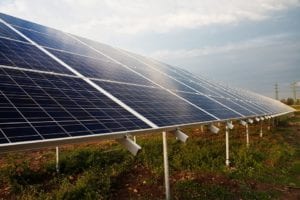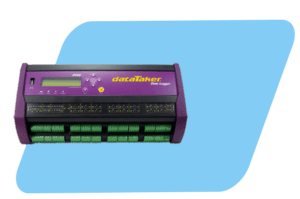dataTaker DT85 Monitors Electrical and Environmental Parameters
 CAS Dataloggers provided a photovoltaic (PV) monitoring system for a solar array. The company’s request was not only for a device to measure the current and voltage output of the solar array but also for environmental monitoring of local conditions since the plant is in a location where extreme temperature excursions often occur. The requirements for the project included not just the DC voltage and current generated by the solar panels, but also:
CAS Dataloggers provided a photovoltaic (PV) monitoring system for a solar array. The company’s request was not only for a device to measure the current and voltage output of the solar array but also for environmental monitoring of local conditions since the plant is in a location where extreme temperature excursions often occur. The requirements for the project included not just the DC voltage and current generated by the solar panels, but also:
Parameters:
- The Temperature of the Solar Panels
- Ambient Temperature
- Relative Humidity
- Solar Radiation
- Wind Speed
Data Logging System:
The dataTaker DT85 is the heart of the proposed PV monitoring system. This rugged data logger is the ideal solution for this application, with 16 universal analog input channels that are suitable for use with a wide range of different sensor types plus digital and counter channels. The logger has a robust design so it can be used in the extended temperature range encountered at the site. Its low-power operation allows it to operate continuously using an internal backup battery in locations where main power is not always available. It also offers extensive local programming functions including calculations, logic, alarms, and a variety of communications that includes Ethernet, RS232/422/485 Serial, USB, Modbus, and SDI-12. The DT85 has an internal non-volatile data memory for up to 10 million data points so it can store large amounts of data for extended operation between downloads.
DC Current Measurement:
For measurement of the DC current output of the solar array, current transducers from CR Magnetics, model CR5220S, are installed on the electrical cables and connected to the data logger. These devices offer a standard 4-20mA current output and split-core design to make installation a snap. A standard 100-ohm shunt resistor is used at the logger to convert the 4-20 mA signal to a voltage which is then read and scaled by the data logger. Similar to a normal CT, these transducers are available in a range of models for DC currents up to 300ADC and provide full isolation from the current being measured.
DC Voltage Measurement:
Because the PV array contained a number of panels wired in series, the total voltage output was well beyond the 50 VDC maximum that the data logger could measure directly. To capture the voltage in a safe and reliable way, we used a CR Magnetics CR5320 DC voltage transducer. It is available in different models that can accommodate up to 600 VDC and provide full voltage isolation from the inputs to the output. Similar to the dc current transducer, this unit provides a 4-20 mA output which was passed through a shunt resistor at the data logger, measured, and scaled back to the appropriate voltage value.
Temperature & Humidity Measurement:
There are numerous vendors of temperature and humidity sensors, however many are not compatible with the extreme conditions of outdoor monitoring. For this application, the meteorological grade MP400A probe from Rotronic was used. The sensor has a measurement range of 0 to 100% RH and -40 to 85°C. Like the DC voltage and current transducers, the 400A offers standard 4-20mA current outputs for both humidity and temperature. The measurement setup was identical to the 2 previous sensors; the 4-20 mA current was passed through a shunt resistor, and the resulting voltage was measured by the data logger and scaled to the appropriate units.
Solar Radiation Measurement:
A device called a pyranometer is commonly used to measure solar radiation. For this PV monitoring project, an Apogee Instruments SP110-SS pyranometer was used. This sensor outputs a millivolt level signal that is proportional to both the solar intensity and the angle of incidence. This allows the sensor to more accurately determine the amount of light that is shining directly down on the solar array. It is based on a silicon cell sensor, which is the best solar radiation measurement technology for the photovoltaic industry. The output signal was fed directly into the datalogger as the DT85 has no issue accurately measuring voltages in the mV range. In the logger, the voltage is scaled to standard intensity units of W/m2.
Wind Speed Measurement:
An anemometer is required to measure the wind speed, a device normally used in weather stations. The simple, classical wind-cup type is still the most reliable anemometer for this kind of application; here we used the Novalynx 200-WS-01 wind speed sensor. This unit uses a small magnetic reed switch which is opened and closed as the cups spin. This switch is attached to one of the high-speed counter inputs on the DT85. The datalogger counts the number of switch closures (pulses) in a given interval and makes the conversion between pulse count and wind speed.
Web Setup
 Provided with the dataTaker DT85, the dEX 2.0 Windows software is used to configure the various sensor inputs and measurement schedules. It allows the user to build custom dashboards with a variety of gauges and trend charts. Data can also be exported to a CSV file for use with spreadsheet applications.
Provided with the dataTaker DT85, the dEX 2.0 Windows software is used to configure the various sensor inputs and measurement schedules. It allows the user to build custom dashboards with a variety of gauges and trend charts. Data can also be exported to a CSV file for use with spreadsheet applications.
Data Transfer and Alarms
The Ethernet port built into the DT85 can be used to send data via FTP or email as CSV text files. Alarms are easily set up through the web server. When user-set thresholds are reached, alarms can also be sent via email.
Conclusion
The PV monitoring system described provides a cost-effective example of data collection with the dataTaker DT85 Universal Input Data Logger. The universal analog and digital inputs allow not only the measurements related to the power produced by the solar panels but also various environmental monitoring including solar radiation and wind speed measurement. And, via the data loggers, Ethernet automatically sends data and alarms.
For further information on the DT85 data logger, and other dataTaker products, or to find the ideal solution for your application-specific needs, contact a CAS Data Logger Applications Specialist at (800) 956-4437 or request more information.

